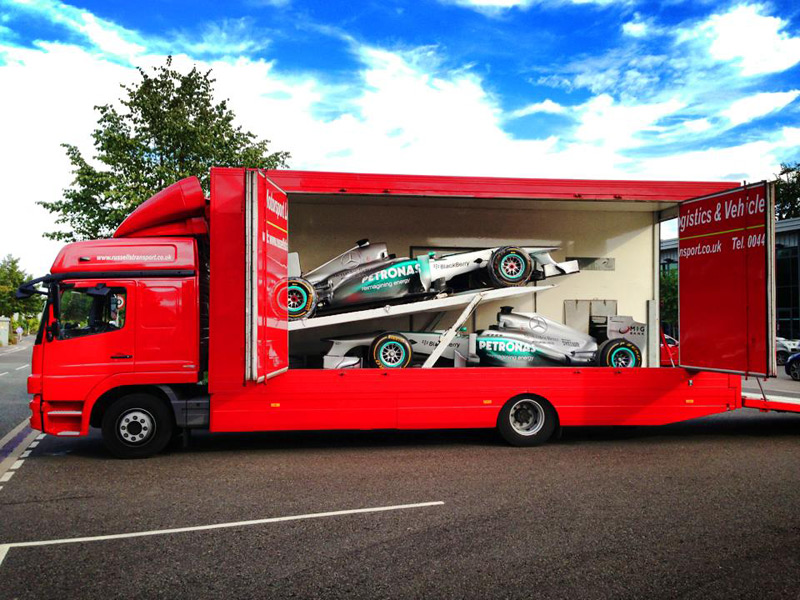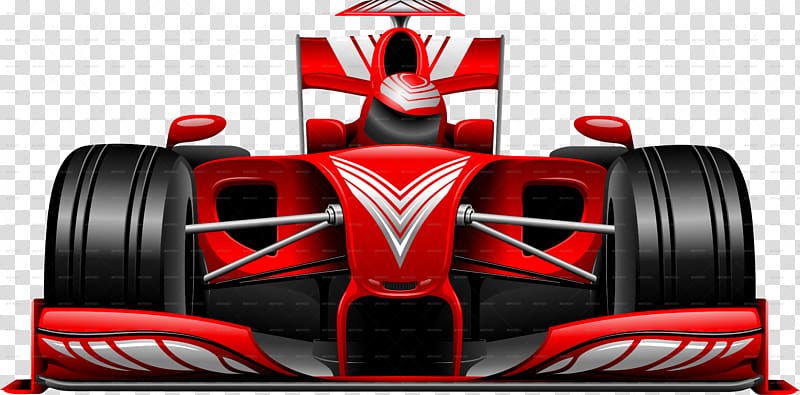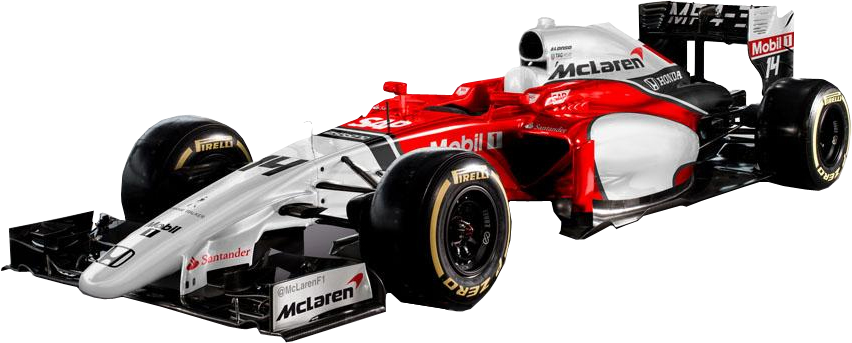Yet despite these changes, constructors continued to extract performance gains by increasing power and aerodynamic efficiency. As a result, the pole position speed at many circuits in comparable weather conditions dropped between 1.5 and 3 seconds in 2004 over the prior year's times. The aerodynamic restrictions introduced in 2005 were meant to reduce downforce by about 30%, however, most teams were able to successfully reduce this to a mere 5 to 10% downforce loss. In 2006 the engine power was reduced from 710 to 560 kW by shifting from the 3.0L V10s, used for a decade, to 2.4L V8s. Formula 1 cars are some of the fastest and radically accelerating vehicles on Earth and are considered by many car enthusiasts to be the pinnacle of motorsports.
Today's F times are exponentially faster than predecessors of even a couple decades ago. Formula One race cars have been recorded to reach 0-60 as fast as 1.6 seconds, however the typical range for modern day F1 cars is between 2.1 to 2.7 seconds. The 2007 Honda RA107 f1 race car goes mph in a blistering 4 seconds flat.
The 2015 Infiniti Red Bull RB11 Formula One race car jets 0 to 60 in only 1.7 seconds, and perhaps even more impressive can reach 190 mph in under 10 seconds. Although top fuel dragsters hold the top spot for fastest accelerating race car class, the F1 race car boasts a range of superior performance stats. F times are extreme, however so are their ability to perform incredibly tight high speed maneuvers, decelerate and reach impressively high top speeds. Under hard braking or cornering a typically F1 car will pull 4g's, which is over 4 times as much as a 2014 Corvette Stingray Z51 would do which produces a max of 1.03g in hard cornering. The power to weight ratio of F1 race cars would actually allow for better performance, however current traction technology limits the capability to improve these current stats. Most F1 cars weigh around 1,300 pounds with the driver and boast over 750 horsepower.
In other words, the power-to-weight ratio of formula one race cars is credited for the spectacular acceleration. This kind of weight distribution puts an emphasis on light drivers. With heavier driver that means less freedom on weight distribution and playing with ballast. The rules are the way they are because the teams keep voting them that way, so they can't do much other than say 'well, that's what we asked for'. This problem will be even more noted during 2014 because new 1.6 turbo engines are turning out to be heavier than anticipated and teams are still struggling to meet the minimum weight limit as a result. So having a taller - and therefore heavier - driver can put a team at a disadvantage because it means they are likely to be over the weight limit.
The issue matters because 1kg of weight equates to about 0.035 seconds a lap on an average circuit. And even if they can, the taller driver is at a disadvantage because his weight is high up in the car, which also affects Center of Gravity and therefore performance. It's an unfair advantage you really shouldn't have just by being born smaller because you lose a lot of tools to adjust the car. As a result they will not have as much - or any - ballast to place elsewhere in the car because you're so limited.
People say the weight distribution is fixed so there is no problem, but there is still allowed 1% which is a lot in F1 and you can move it around and put the ballast where you want. The driver has the ability to fine-tune many elements of the race car from within the machine using the steering wheel. The wheel can be used to change gears, apply rev. limiter, adjust fuel/air mix, change brake pressure, and call the radio. Data such as engine rpm, lap times, speed, and gear are displayed on an LCD screen. The wheel hub will also incorporate gear change paddles and a row of LED shift lights. The wheel alone can cost about $50,000, and with carbon fibre construction, weighs in at 1.3 kilograms.
In the 2014 season, certain teams such as Mercedes have chosen to use larger LCDs on their wheels which allow the driver to see additional information such as fuel flow and torque delivery. They are also more customizable owing to the possibility of using much different software. © Craig ScarboroughTo simplify the scrutineering process and equalize the cars, F1 has mandated a minimum weight for the car, complete with driver for many years to come. This has worked well so far, as all the cars are theoretically at the same basic minimum weight across the grid. However, issues have arisen with the current heavier hybrid power units, along with the desire for longer wheelbases and increasing weight of the tyres. All these factors have led to the weight of the car increasing, leading to pressure on the team to either compensate with an overweight car or a lighter driver.
While the former obviously directly hits the car's performance, the latter risks the driver facing fatigue in an attempt to be underweight for the race. Thus, for the 2022 season, the FIA has made technical changes to the aerodynamic characteristics of the cars to reduce the amount of this 'dirty air' and allow for easier overtaking. A substantial amount of downforce is provided by using a rear diffuser which rises from the undertray at the rear axle to the actual rear of the bodywork. However, this drag is more than compensated for by the ability to corner at extremely high speed.
Modern-day Formula One cars are constructed from composites of carbon fibre and similar ultra-lightweight materials. The minimum weight permissible is 740 kg including the driver but not fuel. Prior to the 2014 F1 season, cars often weighed in under this limit so teams added ballast in order to add weight to the car. The advantage of using ballast is that it can be placed anywhere in the car to provide ideal weight distribution.
This can help lower the car's centre of gravity to improve stability and also allows the team to fine-tune the weight distribution of the car to suit individual circuits. Revised regulations introduced in 2005 forced the aerodynamicists to be even more ingenious. In a bid to cut speeds, the FIA reduced downforce by raising the front wing, bringing the rear wing forward, and modifying the rear diffuser profile.
The designers quickly regained much of this loss, with a variety of intricate and novel solutions such as the 'horn' winglets first seen on the McLaren MP4-20. Most of those innovations were effectively outlawed under even more stringent aero regulations imposed by the FIA for 2009. The changes were designed to promote overtaking by making it easier for a car to closely follow another.
The new rules took the cars into another new era, with lower and wider front wings, taller and narrower rear wings, and generally much 'cleaner' bodywork. Perhaps the most interesting change, however, was the introduction of 'moveable aerodynamics', with the driver able to make limited adjustments to the front wing from the cockpit during a race. The success of composite materials in providing stiffness efficiencies and weight reduction in Formula 1 cars is well documented. Much of the sport's improved safety record in recent years derives from the controlled fracture behaviour of composite materials.
Research and understanding of the impact and fracture behaviour of these materials has enabled the design of a sophisticated driver protection system into the vehicles' structure at minimum weight penalty. The chassis itself has evolved into a "survival cell" capable of tolerating damage from minor incidents whilst at the same time being able to protect the driver in the event of a major impact. Combined with this are specialised structural devices designed to absorb large amounts of energy per unit mass by controlled fracture and disintegration.
A number of safety issues were raised by injuries caused to drivers by Foreign Object Damage. This generally involved penetration of the survival cell by broken pieces from theirs or other competitors' vehicles. In an attempt to combat this potentially very dangerous occurrence, a "side intrusion" test was been introduced. Each team is required to submit a panel for testing which is representative of the construction of their monocoque.
A minimum load must be reached prior to full penetration, coupled with the absorption of a minimum amount of energy. The pass criteria for the test also stipulate a non-catastrophic failure mode. Due to increasing environmental pressures from lobby groups and the like, many have called into question the relevance of Formula 1 as an innovating force towards future technological advances . The FIA has been asked to consider how it can persuade the sport to move down a more environmentally friendly path.
The system aims to reduce the amount of kinetic energy converted to waste heat in braking, converting it instead to a useful form to be later fed back through the engine to create a power boost. However, unlike road car systems that automatically store and release energy, the energy is only released when the driver presses a button and is useful for up to 6.5 seconds, giving an additional 60 kW and 400 kJ. It effectively mimics the 'push to pass' button from IndyCar and A1GP series. KERS was not seen in the 2010 championship – while it was not technically banned, the FOTA collectively agreed not to use it. It however made a return for the 2011 season, with all teams except HRT, Virgin and Lotus utilizing the device.
(From 2013 DRS is available only at the pre-determined points during all sessions). The system "stalls" the rear wing by opening a flap, which leaves a 50 mm horizontal gap in the wing, thus massively reducing drag and allowing higher top speeds. However, this also reduces downforce so it is normally used on long straight track sections or sections which do not require high downforce. The system was introduced to promote more overtaking and is often the reason for overtaking on straights or at the end of straights where overtaking is encouraged in the following corner.
However, the reception of the DRS system has differed among drivers, fans, and specialists. In the late 1960s, Jim Hall of Chaparral, first introduced "ground effect" downforce to auto racing. After technical challenges from other teams, it was withdrawn after a single race. Rule changes then followed to limit the benefits of 'ground effects' – firstly a ban on the skirts used to contain the low-pressure area, later a requirement for a 'stepped floor'. The regulations governing the cars are unique to the championship and specify that cars must be constructed by the racing teams themselves, though the design and manufacture can be outsourced.
© Craig ScarboroughAnother rule change to balance things up between teams running different engines is to limit oil usage. This is a key factor for the so-called 'party mode' engine settings used in qualifying and tactically through the race. Although rules have been introduced over the past few years to reduce this practice, loopholes still exist within the regulations.
While there are now limits on oil consumption, the rules pertain to the main engine oil tank. This, therefore, ignores the auxiliary oil tank run by all cars for decades, this second tank introduces extra oil into the main oil circuit as the oil level naturally drops during a stint or race. Now, the Auxiliary oil tank must be empty during qualifying to ensure that extra oil cannot be burnt and undetected for a power boost during full power modes in qualifying. Lower budgets and increased weight makes IndyCar cars quite different to F1 cars to help everyone compete on a level playing field. IndyCars use the same chassis and almost similar engines and gearboxes.
IndyCar Series teams are permitted to design and build their accessories such as suspensions and brake ducts. This is necessary for cars that race across ovals, street and road circuits. From this graph, it is clear the introduction of hybrid technology in 2014 accelerated this trend. Even though the kinetic energy recovery system increased the minimum weight to 640kg in 2011, the first considerable weight gain came in 2014 when F1 radically changed the rules for the car.
These rules introduced the V6 turbo-hybrid engine, resulting in a massive 50kg increase in minimum weight to facilitate the new engines. Also known as adjustable rear wings, DRS rear wings allow the driver to adjust the wing between two pre-determined settings from the cockpit. The F regulations specify that the minimum weight of the car will increase from 743Kg to 768Kg. The main contributors to this are the larger 18inch wheels and tyres, the power unit, standard parts as well as some additional safety features. The overall aerodynamic grip was dramatically reduced with the banning of complex appendages such as winglets, bargeboards and other aero devices previously used to better direct airflow over and under the cars. The maximum engine speed was reduced to 18,000 rpm to increase reliability further and conform to engine life demand.
The carbon brakes in combination with tyre technology and the car's aerodynamics produce truly remarkable braking forces. The deceleration force under braking is usually 4 g (39 m/s2), and can be as high as 5–6 g when braking from extreme speeds, for instance at the Gilles Villeneuve circuit or at Indianapolis. Here the aerodynamic drag actually helps, and can contribute as much as 1.0 g of braking, which is the equivalent of the brakes on most road sports cars. In other words, if the throttle is let go, the F1 car will slow down under drag at the same rate as most sports cars do with braking, at least at speeds above 250 km/h .
Every single surface of a modern Formula One car, from the shape of the suspension links to that of the driver's helmet – has its aerodynamic effects considered. Disrupted air, where the flow 'separates' from the body, creates turbulence which creates drag – which slows the car down. Despite this, designers can't make their cars too 'slippery', as a good supply of airflow has to be ensured to help dissipate the vast amounts of heat produced by the engine and brakes. The front and rear wings feature separate blades to not only reduce drag on straights but to also increase downforce when cornering.
In fact, every surface of a Formula 1 race car – even the driver's helmet – is taken into consideration when working on the aerodynamics of the race car for different tracks. Another engine minimum weight increase for 2021 and bigger tyres make the cars 752kg this season. Next year, following the addition of 18-inch wheels and some standardised components to save costs, the cars will reach a new peak weight of 790kg. Weight Balance is also a F1 specific tuning option and works hand in hand with the ballast. But the best current F1 designs with their special materials like titanium, carbon and magnesium may leave a car weighing something like 450kg. These days, the 450kg may be made up of a 90kg engine, a 50kg monocoque, a 40kg gearbox and the same weight for the four wheels, an 11kg rear wing and so on, with the average driver contributing about 70kg.
That's a long way below a classic from the past, like the Mercedes-Benz W196 which Fangio drove to win the championship 50 years ago. The regulations for the 2014 season limit the maximum fuel mass flow to the engine to 100 kg/h, which reduces the maximum power output from the current 550 kW to about 450 kW. An additional electric motor-generator unit may be connected to the turbocharger. Since the start of the 2011 season, cars have been allowed to run with an adjustable rear wing, more commonly known as DRS , a system to combat the problem of turbulent air when overtaking. On the straights of a track, drivers can deploy DRS, which opens the rear wing, reduces the drag of the car, allowing it to move faster. As soon as the driver touches the brake, the rear wing shuts again.
The FIA has continually enforced material and design restrictions to limit power. Even with the restrictions, the V10s in the 2005 season were reputed to develop 730 kW , power levels not seen since before the ban on turbo-charged engines in 1989. This ballast can be placed anywhere on the car, so it can alter the car's center of gravity , by being placed low down and/or at one end of the car to tune the front to rear weight bias.
To start, we should examine the weight difference between the two types of cars. The minimum weight of a current F1 car is 1,616 pounds, while an LMP1 car weighs between 1,836 pounds and 1,929 pounds. The weight difference for LMP1 depends on a team's decision to run a hybrid or non-hybrid car as the battery pack adds a bit of weight. The sleek and sculptural silhouette of this Ferrari allows air to pass over the body with minimal drag and maximal down–force, which ensures precision handling even at speeds in excess of two hundred miles per hour. Armed with a hefty budget, teams pour a lot of money into research and improvement of the aerodynamics of a car. All this is done to increase the downforce and increase the cornering speeds of the car.
They can be as heavy as they want or use more than the 100kg fuel ... But this extra weight obviously would be a disadvantage in car performance terms, but you can't be under the 702kg. It's also why lighter weight drivers tend to be more appealing choice wise to teams. A lighter driver gives the team more opportunity to distribute ballast in and around the car to alter or improve lower centre of gravity e.g. to improve car balance/performance.. It's a balancing act with car weight, ballast and driver weight to have 702kg and to attain it by choice rather than just an acceptance. A heavier car will not go as fast or accelerate as fast as a lighter car with the same engine, aerodynamics and grip profiles.
That is why F1 teams try to keep their weight and the weight of their drivers as low as possible. There are regulations surrounding the exact numbers, and as drivers try to stay as close to the minimum weight as possible, it often means they are very skinny. This is what helps keep the car stuck to the road around corners, but downforce plays a key role here too. Aerodynamics are important on the straights, allowing the car to experience less drag. You can find out more about aerodynamics and drag by checking out this article here.
























No comments:
Post a Comment
Note: Only a member of this blog may post a comment.